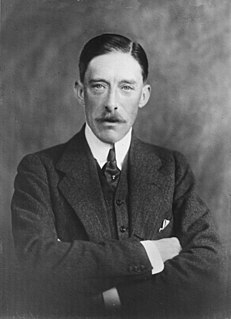Related Research Articles

Harewood House is a country house in Harewood, West Yorkshire, England. Designed by architects John Carr and Robert Adam, it was built, between 1759 and 1771, for Edwin Lascelles, 1st Baron Harewood, a wealthy West Indian plantation and slave-owner. The landscape was designed by Lancelot "Capability" Brown and spans 1,000 acres (400 ha) at Harewood.

Mary, Princess Royal and Countess of Harewood, was the only daughter of King George V and Queen Mary. She was the sister of Kings Edward VIII and George VI, and aunt of the current British monarch, Queen Elizabeth II. In the First World War, she performed charity work in support of servicemen and their families. She married Henry Lascelles, Viscount Lascelles, in 1922. Mary was given the title of Princess Royal in 1932. During the Second World War, she was Controller Commandant of the Auxiliary Territorial Service. The Princess Royal and the Earl of Harewood had two sons, George Lascelles, 7th Earl of Harewood, and The Honourable Gerald Lascelles.

George Henry Hubert Lascelles, 7th Earl of Harewood,, styled The Honourable George Lascelles before 1929 and Viscount Lascelles between 1929 and 1947, was a British classical music administrator and author. He served as director of the Royal Opera House, chairman of the board of the English National Opera (ENO) (1986–95); managing director of the ENO (1972–85), managing director of the English National Opera North (1978–81), governor of the BBC (1985–87), and president of the British Board of Film Classification (1985–96).

Edward Lascelles, 1st Earl of Harewood was a British landowner, art collector, peer and, before which, Member of Parliament.

Henry Lascelles, 2nd Earl of Harewood DL, known as Viscount Lascelles from 1814 to 1820, was a British peer, slave plantation and other land owner, chiefly inheritee art collector, and Member of Parliament.

David Henry George Lascelles, 8th Earl of Harewood, styled as Viscount Lascelles until 2011, is a British hereditary peer and film and television producer. He is a first cousin, once removed, of Queen Elizabeth II and a great-grandson of George V.
Henry North Holroyd, 3rd Earl of Sheffield, styled Viscount Pevensey until 1876, was an English Conservative politician and patron of cricket. The Sheffield Shield is named after him.
Alexander Edgar Lascelles, Viscount Lascelles is an English chef, and the third child and second son of David Lascelles, 8th Earl of Harewood, and his first wife Margaret, Viscountess Lascelles. He is heir apparent to the earldom of Harewood, due to his elder brother having been born before their parents' marriage.

Henry George Charles Lascelles, 6th Earl of Harewood, was a British soldier and peer. He was the husband of Mary, Princess Royal, and thus a son-in-law of George V and Queen Mary and a brother-in-law to Edward VIII and George VI.

Sir Alan Frederick "Tommy" Lascelles, was a British courtier and civil servant who held several positions in the first half of the twentieth century, culminating in his position as Private Secretary to both King George VI and Queen Elizabeth II. In 1950, he wrote the Lascelles Principles in a letter to the editor of The Times, using the pen-name "Senex".
This is a list of those who have held the position of Lord Lieutenant of the West Riding of Yorkshire from its creation in 1660 to its abolition on 31 March 1974. From 1699 until 1974, all Lords Lieutenant were also Custos Rotulorum of the West Riding of Yorkshire. The incumbent Lord Lieutenant became in 1974 Lord Lieutenant of West Yorkshire, covering a smaller area.
Lascelles is an English surname of Norman French origin whose translation means the saddle. The surname was introduced into England by followers of William the Conqueror after 1066. Notable people with the surname include:
Captain William Norman Lascelles Davidson was an English soldier who was an early experimenter in color cinematography.

Thomas Shailer Weston, often referred to as Thomas S. Weston, was a judge and 19th-century Member of Parliament from Westland, New Zealand. Weston was the patriarch of one of two dominant Canterbury families of the legal profession.

Daniel Lascelles (1714–1784) was an plantation owner, merchant and politician who sat in the British House of Commons from 1752 to 1780.
Norman Macdonald Richmond was a New Zealand adult education organiser and tutor, university lecturer, social reformer. He was born in Wellington, New Zealand in 1897. Helen Simpson was his elder sister. After a short war service, he won a Rhodes Scholarship in 1919, and taught at Christ's College in Christchurch before he commenced his studies. He married Hilary Wall in on 1 June 1926; she was the daughter of professor Arnold Wall. He became a lecturer and worked for various organisations and universities in New Zealand and Australia. In later life, he suffered from mental illness and was institutionalised. He died in Wellington on 13 July 1971; his wife had died in 1962.

Jamaal Lascelles is an English professional footballer who plays as a centre-back and captains Premier League club Newcastle United. Lascelles previously played for Nottingham Forest, where he was developed through its youth academy.

Elders Pastoral Limited v Bank of New Zealand [1990] NZPC 3; [1990] UKPC 29; [1990] 3 NZLR 129; [1990] 1 WLR 1090; (1990) 2 PRNZ 333 is a cited case in New Zealand case law regarding constructive trusts.
The Ankamuti were an indigenous Australian people of the Cape York Peninsula of Queensland.
The 1962 Queen's Birthday Honours in New Zealand, celebrating the official birthday of Elizabeth II, were appointments made by the Queen on the advice of the New Zealand government to various orders and honours to reward and highlight good works by New Zealanders. They were announced on 2 June 1962.
References
- ↑ McKelvey, Peter. "Norman Lascelles Elder". Dictionary of New Zealand Biography . Ministry for Culture and Heritage . Retrieved 23 April 2017.